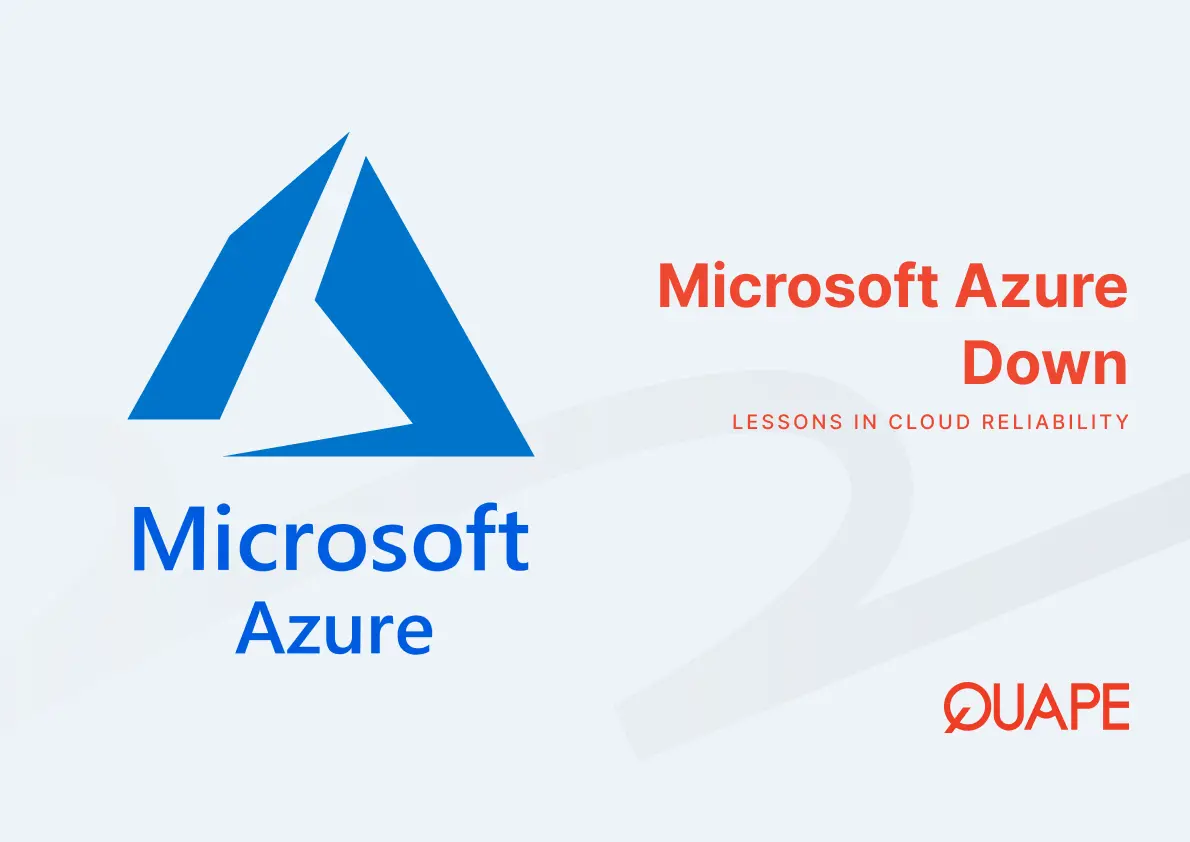On October 29, 2025, businesses around the world experienced something that shouldn’t happen with enterprise-grade cloud infrastructure: their systems went dark for over eight hours.
The culprit? Microsoft Azure, one of the three largest cloud providers in the world. An inadvertent configuration change to Azure Front Door—their global content delivery system—triggered a cascade of failures that affected everything from airline booking systems to gaming servers.
If you’re running your business on cloud infrastructure, this incident offers important lessons about reliability, redundancy, and the hidden risks of concentrated market power.
Table of Contents
ToggleWhat Happened During the Azure Outage?
At its peak, over 18,000 users reported Azure problems on Downdetector, while nearly 20,000 more flagged issues with Microsoft 365. But these numbers only represent individual users who took the time to report the problem. The real impact was far more extensive.
Services Affected:
- Microsoft 365 (email, collaboration tools)
- Xbox Live and Minecraft servers
- Azure Communication Services
- Countless customer websites and applications
Real-World Consequences:
- Alaska Airlines experienced disruptions to their booking website and key operational systems
- Heathrow Airport faced system failures affecting passenger processing
- Businesses relying on Azure-hosted payment systems couldn’t process transactions
According to Microsoft’s official status page, the incident lasted for over eight hours. Even after the fix was deployed, manual node recovery and gradual traffic rerouting took additional hours before services fully returned to normal.
Understanding the Root Cause of Cloud Outages
The technical explanation is straightforward: a configuration change to Azure Front Door—the system that routes traffic across Microsoft’s global network—contained an error. Because AFD sits at the network edge and handles enormous volumes of traffic, this single mistake cascaded across the entire platform.
This is what engineers call a “single point of failure.” When a critical system lacks redundancy, any error—no matter how small—can have massive consequences.
Why Recovery Takes So Long
Rolling back a configuration across a global network isn’t instantaneous. Each step requires validation, gradual deployment to prevent further failures, manual verification, and slow rerouting of traffic. This careful process is necessary—but it means extended downtime for everyone dependent on the platform.
The Bigger Pattern: Cloud Hosting Concentration Risk
What makes this incident particularly concerning isn’t that it happened to Microsoft. It’s that it happened just nine days after a similar incident at Amazon Web Services.
On October 20, 2025, AWS experienced a major outage caused by DNS and DynamoDB resolution problems. That incident disrupted Snapchat, Reddit, Fortnite, and countless other services for hours.
Two of the world’s three largest cloud providers, offline within ten days of each other.
According to industry analysts, the three largest cloud providers—Amazon Web Services, Microsoft Azure, and Google Cloud Platform—control approximately 60-65% of the global cloud infrastructure market. This concentration creates systemic risk. When such a large portion of the internet relies on just three providers, back-to-back outages aren’t just inconvenient—they’re a warning sign.
The Real Cost of Cloud Downtime
Industry estimates suggest that a single hour of downtime can cost an enterprise between $140,000 and $540,000, depending on the business type and size. For eight hours of downtime across thousands of affected businesses, the collective economic impact likely reaches hundreds of millions of dollars.
Beyond the financial cost:
- Operational disruption: Airlines couldn’t process bookings, staff resorted to manual processes
- Customer trust: Businesses had to explain to their customers why systems were unavailable
- Lost opportunities: E-commerce platforms missed sales during peak hours
The 18,000 Downdetector reports represent frustrated individual users—they don’t capture the downstream effects on businesses, government services, and supply chain systems that rely on Azure infrastructure.
Rethinking Your Cloud Hosting Strategy
The recent outages raise questions every business should be asking about their hosting approach.
Key Considerations:
- Can your business tolerate eight hours of downtime? For most businesses in the digital economy, the answer is no.
- Do you have a contingency plan? When your primary hosting provider goes down, what happens to your operations?
- Is market share the right metric? The largest providers have extensive resources, but they also have global systems where a single configuration change can cascade across millions of customers.
The Advantage of Specialized Hosting Providers
There’s a common assumption that bigger cloud providers are inherently more reliable. The October outages challenge that assumption.
Smaller, specialized hosting providers often achieve better uptime precisely because they’re not operating at the scale where a single configuration change affects millions of customers simultaneously. They typically implement more conservative change management practices, maintain smaller blast radiuses for configuration errors, and provide direct access to engineers who understand your specific setup.
The Singapore Advantage
For businesses operating in Singapore and the Asia-Pacific region:
- Timezone alignment: When issues occur during your business hours, your hosting provider’s team is also online and ready to respond
- Data sovereignty: Keeping your data within Singapore simplifies compliance with the Personal Data Protection Act (PDPA)
- Local support: Direct communication with engineers who understand the regional business environment
How Quape Approaches Web Hosting Reliability
Since 2006, Quape has been providing hosting services to Singapore businesses with a focus on consistent uptime and responsive support.
Our web hosting plans use LiteSpeed Web Server, a high-performance platform that delivers event-driven speed while maintaining full compatibility with Apache configurations. We implement infrastructure changes with careful testing and gradual rollouts, specifically to avoid the kind of cascading failures that affected Azure.
When you contact Quape, you’re speaking with engineers who can access your account details and resolve issues—not navigating an automated ticket system designed for millions of users. We back our reliability commitment with a 99% uptime guarantee, reflecting our confidence in our infrastructure and processes.
Conclusion
The October 2025 outages at AWS and Azure demonstrate that market dominance doesn’t guarantee reliability. For Singapore businesses, the “best” hosting provider isn’t necessarily the one with the biggest market share—it’s the provider that matches your specific needs for reliability, support, compliance, and business continuity.
At Quape, we’ve built our reputation on consistent uptime and responsive service. When the next major cloud outage makes headlines, the question is whether your business will be scrambling to explain downtime to your customers, or quietly continuing operations while your competitors deal with the fallout.

- The Microsoft Azure Outage: What It Means for Cloud Hosting Reliability - October 30, 2025





